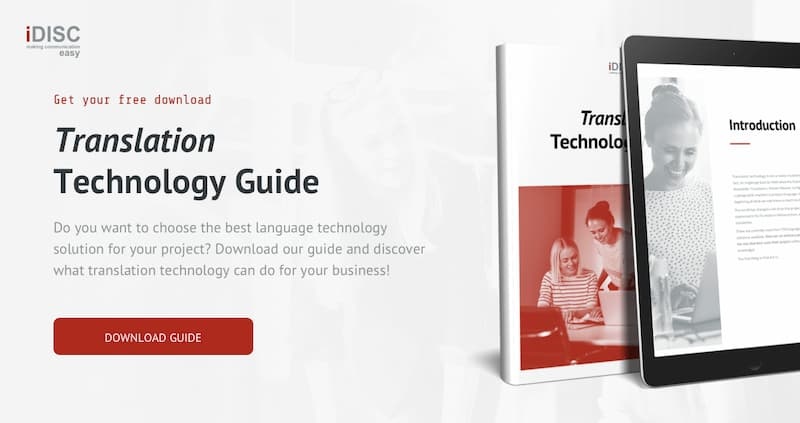As you know, in the digital era, access to global communication has become easier for many businesses, especially for those companies dedicated to audiovisual content.
Netflix, Disney+, HBO Max, Amazon Prime Video... Sound familiar?
These streaming platforms generate an enormous amount of audiovisual content that is enjoyed around the world.
What do you think makes all that possible?
You got it. Translation! In this case we are talking specifically about audiovisual translation.
Audiovisual translation allows these video and audio products to reach global audiences, adapting them to each language and culture.
What types of audiovisual translation are there, what do they consist of, and what is the correct way to adapt audiovisual content to a particular language and culture?
Keep reading to find out.
What is audiovisual translation?
Audiovisual translation takes into account the text as well as the visual and sound elements. The aim is to adapt the content to the specific linguistic and cultural particularities of each audience.
To achieve this, the translator must translate the words from one language to another, but also adapt the expressions, idioms and puns from the original version to the target version, with the necessary sensitivity to respect the essence and character of the audiovisual product they are handling.
To work in audiovisual translation, professionals must have a good command of the languages they work with, in order to properly link the original message with its audience.
Audiovisual translation techniques
Various techniques are used for the translation of audiovisual material:
Subtitling
Subtitles are a very useful tool to make videos more accessible to audiences of different languages. You can keep the video with the voices in the original audio and add text to the image with the translation of the dialogues into the different languages in which you want to launch the product. In addition, subtitling not only helps reach audiences that speak other languages, but also makes products more accessible to hearing-impaired people who need to read dialogue or descriptions of certain sounds.
Dubbing
Dubbing is the audiovisual translation technique by which the original audio is replaced by the spoken version in another language. This requires dubbing actors to replace the voice of the original actors and perform the dialogues in their native language. Dubbing provides viewers with a more immersive experience, which is why it is mainly used in movies and TV series.
One thing about dubbing is that sometimes certain puns and turns of phrase are difficult to translate from one language to another.
Something that many will undoubtedly remember is the controversial translation of one of the most famous phrases in the acclaimed series Game of Thrones. The death of the character Hodor, played by actor Kristian Nairn, was the subject of much discussion.
The interesting aspect of this scene is in discovering the origin of the name of the character, whom everyone calls Hodor because it is the only thing he knows how to say as a result of his trauma.
In the original version, the words spoken by the actor are “Hold the door”, which gradually transform into “Hold door”, “Hol dor” and eventually resolve into “Hodor”, the only word the character is capable of pronouncing.
In the Spanish version, viewers listened as the words “Aguanta el portón” (hold the door) slowly transform into “Hodor”. Clearly, it doesn’t have the same impact. The translators and dubbing artists had a difficult job.
This is why it is so important to have professional audiovisual translators who can find good linguistic matches that have the same impact as the original.
Voice-over
This technique can be an alternative to dubbing, since it does not require replacing the original voice with another, but superimposing an audio track in the language into which it has been translated, leaving the original sound in the background.
Voice-over is not very common in TV series or movies, but it is very common in documentaries or corporate videos. It is more economical than dubbing.
Audiovisual localization
When we talk about localization in the audiovisual world, we are referring to everything we have mentioned above, and we also include the visual elements that appear on the screen, which must also be adapted to the target culture and language. This involves translating 2D texts that appear on screen in the original version, as well as 3D texts that are part of the recording, such as a book cover, posters or road signs.
As in any process in which we adapt a product to the language of the target market, audiovisual localization is essential to allow the viewer to understand the message to be conveyed and to connect emotionally with it.
As you can see, everything always leads us to the same basic premise: for audiovisual translation to be effective, we must take cultural adaptation into account.
And to carry out cultural adaptation of an audiovisual product there are several strategies that we will look at below.
Localization strategies for audiovisual translation
Naturalization or domestication
This involves eliminating the entire cultural reference of the original text or dialogue and translating it with a reference that makes sense in the target market’s culture.
With this technique, puns or characters known in the culture of the original language are replaced in the target market version by references from that culture instead.
These kinds of parallels make viewers connect with what we are telling them and can only be drawn by translators with true knowledge of the cultures they are working with.
For example, in the original version of an English movie we might hear the expression “Spill the tea”. A literal translation of this phrase would not make sense, since, although it literally means “to spill the tea”, it is an idiom that refers to revealing gossip. As a result, in a version dubbed for Mexico we would probably hear something like “Cuéntame el chisme” (tell me the gossip).
Foreignization
This is the exact opposite of domestication. The original cultural references are left exactly the same. This means that if the original version mentions famous or influential people within the original market’s culture and society, such as Michael Jackson or Mick Jagger, they will not be replaced by singers such as Julio Iglesias or Miguel Bosé in the Spanish version, who are better known among the Spanish public.
Neutralization
This technique tries to explain the concept of the original text without going into too much detail. This may involve searching for a term or word that can encompass the original meaning.
For example, in many areas of the world, the Kleenex brand was so successful that it even changed the way speakers named the product itself, even if it was not Kleenex branded, replacing the term “tissues” with “kleenex”.
If this word were to appear in audiovisual content that was to be dubbed for another country where this trademark had not been so widely used, using the neutralization technique, a trademark with a similar impact on its culture would not be sought, but simply replaced by the translation of “tissues”.
As you can see, audiovisual translation is a very powerful tool that, when used well, can help you reach global audiences successfully.
Making your video and audio products accessible to different languages and different cultures will undoubtedly increase the impact on your audience in the target markets you want to expand into.
Good audiovisual translation can increase the reach of your project. If you are looking for a translation partner specialized in audiovisual translations, don’t hesitate to contact us.
If you want to stay up to date on the latest trends in translation and international marketing strategies, don’t miss our blog.





